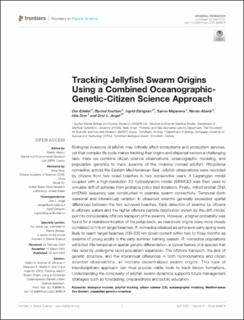| dc.contributor.author | Edelist, Dor | |
| dc.contributor.author | Knutsen, Øyvind | |
| dc.contributor.author | Ellingsen, Ingrid H. | |
| dc.contributor.author | Majaneva, Sanna | |
| dc.contributor.author | Aberle-Malzahn, Nicole | |
| dc.contributor.author | Dror, Hila | |
| dc.contributor.author | Angel, Dror L. | |
| dc.date.accessioned | 2023-01-19T10:13:57Z | |
| dc.date.available | 2023-01-19T10:13:57Z | |
| dc.date.created | 2022-08-09T12:08:16Z | |
| dc.date.issued | 2022 | |
| dc.identifier.citation | Edelist D, Knutsen Ø, Ellingsen I, Majaneva S, Aberle N, Dror H and Angel DL (2022) Tracking Jellyfish Swarm Origins Using a Combined Oceanographic-Genetic-Citizen Science Approach. Front. Mar. Sci. 9:869619. doi: 10.3389/fmars.2022.869619 | en_US |
| dc.identifier.issn | 2296-7745 | |
| dc.identifier.uri | https://hdl.handle.net/11250/3044539 | |
| dc.description.abstract | Biological invasions of jellyfish may critically affect ecosystems and ecosystem services, yet their complex life cycle makes tracking their origins and dispersal vectors a challenging task. Here we combine citizen science observations, oceanographic modeling, and population genetics to track swarms of the invasive nomad jellyfish, Rhopilema nomadica, across the Eastern Mediterranean Sea. Jellyfish observations were recorded by citizens from two Israeli beaches in two consecutive years. A Lagrangian model coupled with a high-resolution 3D hydrodynamic model (SINMOD) was then used to simulate drift of ephyrae from probable polyp bed locations. Finally, mitochondrial DNA (mtDNA) sequence was constructed to examine swarm connectivity. Temporal (both seasonal and interannual) variation in observed swarms generally exceeded spatial differences between the two surveyed beaches. Early detection of swarms by citizens in offshore waters and the higher offshore particle distribution shown by the drift model, point to considerable offshore transport of the swarms. However, a higher probability was found for a nearshore location of the polyp beds, as nearshore origins were more closely correlated to hits on target beaches. R. nomadica released as ephyrae in early spring were likely to reach target beaches 200-300 km down current within two to three months as swarms of young adults in the early summer bathing season. R. nomadica populations exhibited little temporal or spatial genetic differentiation, a typical feature of a species that has recently undergone rapid population expansion. The offshore transport, the lack of genetic structure, and the interannual differences in both hydrodynamics and citizen scientist observations, all indicate decentralized swarm origins. This type of interdisciplinary approach can thus provide viable tools to track bloom formations. Understanding the complexity of jellyfish swarm dynamics supports future management strategies such as forecasting, preparedness and public education. | en_US |
| dc.language.iso | eng | en_US |
| dc.publisher | Frontiers | en_US |
| dc.rights | Navngivelse 4.0 Internasjonal | * |
| dc.rights.uri | http://creativecommons.org/licenses/by/4.0/deed.no | * |
| dc.subject | population genetics-empirical | en_US |
| dc.subject | Mediterranean Sea-Eastern | en_US |
| dc.subject | oceanographic modeling | en_US |
| dc.subject | citizen science (CS) | en_US |
| dc.subject | jellyfish tracking | en_US |
| dc.subject | biological invasion | en_US |
| dc.title | Tracking jellyfish swarm origins using a combined oceanographic-genetic-citizen science approach | en_US |
| dc.title.alternative | Tracking jellyfish swarm origins using a combined oceanographic-genetic-citizen science approach | en_US |
| dc.type | Peer reviewed | en_US |
| dc.type | Journal article | en_US |
| dc.description.version | publishedVersion | en_US |
| dc.rights.holder | Copyright © 2022 Edelist, Knutsen, Ellingsen, Majaneva, Aberle, Dror and Angel. | en_US |
| dc.source.pagenumber | 1-15 | en_US |
| dc.source.volume | 9 | en_US |
| dc.source.journal | Frontiers in Marine Science | en_US |
| dc.identifier.doi | 10.3389/fmars.2022.869619 | |
| dc.identifier.cristin | 2041931 | |
| dc.relation.project | Sigma2: NN2967K | en_US |
| dc.relation.project | EC/H2020/774499 | en_US |
| cristin.ispublished | true | |
| cristin.fulltext | original | |
| cristin.qualitycode | 1 | |

